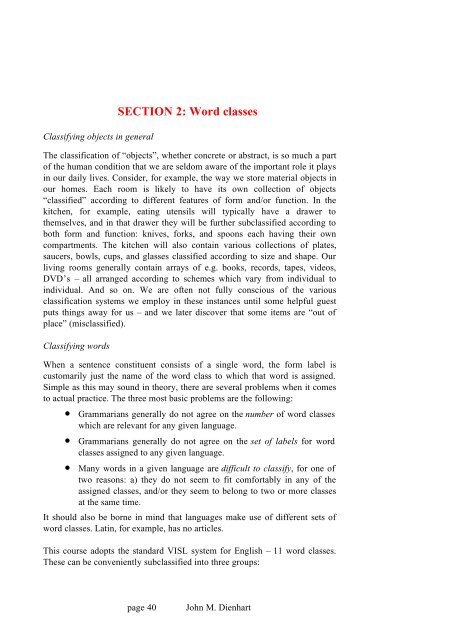Download - VISL
Download - VISL
Download - VISL
Create successful ePaper yourself
Turn your PDF publications into a flip-book with our unique Google optimized e-Paper software.
Classifying objects in general<br />
SECTION 2: Word classes<br />
The classification of “objects”, whether concrete or abstract, is so much a part<br />
of the human condition that we are seldom aware of the important role it plays<br />
in our daily lives. Consider, for example, the way we store material objects in<br />
our homes. Each room is likely to have its own collection of objects<br />
“classified” according to different features of form and/or function. In the<br />
kitchen, for example, eating utensils will typically have a drawer to<br />
themselves, and in that drawer they will be further subclassified according to<br />
both form and function: knives, forks, and spoons each having their own<br />
compartments. The kitchen will also contain various collections of plates,<br />
saucers, bowls, cups, and glasses classified according to size and shape. Our<br />
living rooms generally contain arrays of e.g. books, records, tapes, videos,<br />
DVD’s – all arranged according to schemes which vary from individual to<br />
individual. And so on. We are often not fully conscious of the various<br />
classification systems we employ in these instances until some helpful guest<br />
puts things away for us – and we later discover that some items are “out of<br />
place” (misclassified).<br />
Classifying words<br />
When a sentence constituent consists of a single word, the form label is<br />
customarily just the name of the word class to which that word is assigned.<br />
Simple as this may sound in theory, there are several problems when it comes<br />
to actual practice. The three most basic problems are the following:<br />
• Grammarians generally do not agree on the number of word classes<br />
which are relevant for any given language.<br />
• Grammarians generally do not agree on the set of labels for word<br />
classes assigned to any given language.<br />
• Many words in a given language are difficult to classify, for one of<br />
two reasons: a) they do not seem to fit comfortably in any of the<br />
assigned classes, and/or they seem to belong to two or more classes<br />
at the same time.<br />
It should also be borne in mind that languages make use of different sets of<br />
word classes. Latin, for example, has no articles.<br />
This course adopts the standard <strong>VISL</strong> system for English – 11 word classes.<br />
These can be conveniently subclassified into three groups:<br />
page 40<br />
John M. Dienhart
















